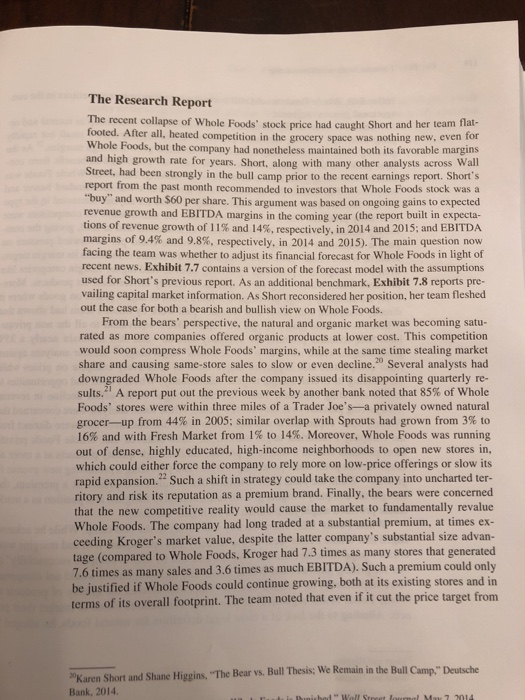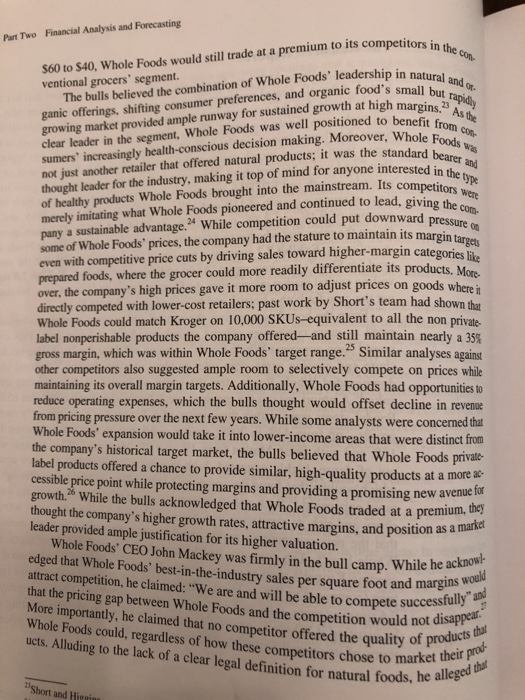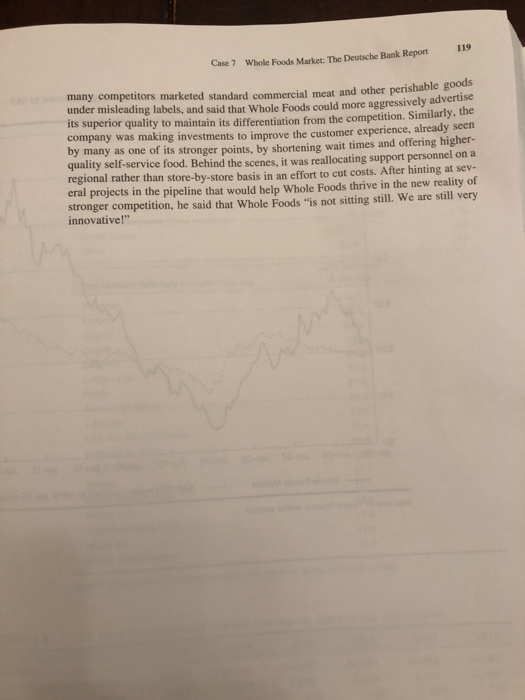Please highlight important points of the report in a summary

The Research Report The recent collapse of Whole Foods' stock price had caught Short and her team flat- footed. After all, heated competition in the grocery space was nothing new, even for Whole Foods, but the company had nonetheless maintained both its favorable margins and high growth rate for years. Short, along with many other analysts across Wall Street, had been strongly in the bull camp prior to the recent earnings report. Short's report from the past month recommended to investors that Whole Foods stock was a "buy" and worth $60 per share. This argument was based on ongoing gains to expected revenue growth and EBITDA margins in the coming year (the report built in expecta- tions of revenue growth of 11% and 14 % , respectively, in 2014 and 2015; and EBITDA margins of 9.4% and 9.8 % , respectively, in 2014 and 2015). The main question now facing the team was whether to adjust its financial forecast for Whole Foods in light of recent news. Exhibit 7.7 contains a version of the forecast model with the assumptions used for Short's previous report. As an additional benchmark, Exhibit 7.8 reports pre- vailing capital market information. As Short reconsidered her position, her team fleshed out the case for both a bearish and bullish view on Whole Foods. From the bears' perspective, the natural and organic market was becoming satu- rated as more companies offered organic products at lower cost. This competition would soon compress Whole Foods' margins, while at the same time stealing market share and causing same-store sales to slow or even decline.20 Several analysts had downgraded Whole Foods after the company issued its disappointing quarterly re- sults. A report put out the previous week by another bank noted that 85% of Whole Foods' stores were within three miles of a Trader Joe's-a privately owned natural grocer-up from 44 % in 2005; similar overlap with Sprouts had grown from 3% to 16% and with Fresh Market from 19% to 14 % . Moreover, Whole Foods was running out of dense, highly educated, high-income neighborhoods to open new stores in, which could either force the company to rely more on low-price offerings or slow its rapid expansion.2 Such a shift in strategy could take the company into uncharted ter- ritory and risk its reputation that the new competitive reality would cause the market to fundamentally revalue Whole Foods. The company had long traded at a substantial premium, at times ex- ceeding Kroger's market value, despite the latter company's substantial size advan- tage (compared to Whole Foods, Kroger had 7.3 times as many stores that generated 7.6 times as many sales and 3.6 times as much EBITDA). Such a premium could only be justified if Whole Foods could continue growing, both at its existing stores and in terms of its overall footprint. The team noted that even if it cut the price target from premium brand. Finally, the bears were concerned as a S 20Karen Short and Shane Higgins, "The Bear vs. Bull Thesis; We Remain in the Bull Camp." Deutsche Bank, 2014. ched " Woll Steeet lourmal ay 7 2014 Financial Analysis and Forecasting Part Two $60 to $40, Whole Foods would still trade at a premium to its competitors in the con The bulls believed the combination of Whole Foods' leadership in natural and or- ventional grocers' segment. ganic offerings, shifting consumer preferences, and organic food's small but rapidly growing market provided ample runway for sustained growth at high margins." As the clear leader in the segment, Whole Foods was well positioned to benefit from con sumers' increasingly health-conscious decision making. Moreover, Whole Foods was not just another retailer that offfered natural products; it was the standard bearer and thought leader for the industry, making it top of mind for anyone interested in the type of healthy products Whole Foods brought into the mainstream. Its competitors were merely imitating what Whole Foods pioneered and continued to lead, giving the com pany a sustainable advantage. While competition could put downward pressure o some of Whole Foods' prices, the company had the stature to maintain its margin targets even with competitive price cuts by driving sales toward higher-margin categories lik prepared foods, where the grocer could more readily differentiate its products. M over, the company's high prices gave it more room to adjust prices on goods where it directly competed with lower-cost retailers; past work by Short's team had shown that Whole Foods could match Kroger on 10,000 SKUS-equivalent to all the non private label nonperishable products the company offered-and still maintain nearly a 35% gross margin, which was within Whole Foods' target range. Similar analyses against other competitors also suggested ample room to selectively compete on prices while maintaining its overall margin targets. Additionally, Whole Foods had opportunities to reduce operating expenses, which the bulls thought would offset decline in revenue from pricing pressure over the next few years. While some analysts were concerned that Whole Foods' expansion would take it into lower-income areas that were distinct from the company's historical target market, the bulls believed that Whole Foods private label products offered a chance to provide similar, high-quality products at a more a- cessible price point while protecting margins and providinga promising new avenue tor growth.t While the bulls acknowledged that Whole Foods traded at a premium, the thought the company's higher growth rates, attractive margins, and position leader provided ample justification for its higher valuation. Whole Foods' CEO John Mackey 25 S as a market firmly in the bull camp. While he acknow- edged that Whole Foods' best-in-the-industry sales per square foot and margins would attract competition, he claimed: "We are and will be able to compete successfully" and that the pricing gap between Whole Foods and the competition would not disappear." was More importantly, he claimed that no Whole Foods could, regardless of how these competitors chose to market their prod competitor offered the quality of products that ucts. Alluding to the lack of a clear legal definition for natural foods, he alleged that BShort and Higging 119 Whole Foods Market: The Deutsche Bank Report Case 7 many competitors marketed standard commercial meat and other perishable goods under misleading labels, and said that Whole Foods could more aggressively advertise its superior quality to maintain its differentiation from the competition. Similarly, the company was making investments to improve the customer experience, already seen by many as one of its stronger points, by shortening wait times and offering higher- quality self-service food. Behind the scenes, it was reallocating support personnel on a regional rather than store-by-store basis in an effort to cut costs. After hinting at sev- eral projects in the pipeline that would help Whole Foods thrive in the new reality of stronger competition, he said that Whole Foods "is not sitting still. We are still very innovative!" The Research Report The recent collapse of Whole Foods' stock price had caught Short and her team flat- footed. After all, heated competition in the grocery space was nothing new, even for Whole Foods, but the company had nonetheless maintained both its favorable margins and high growth rate for years. Short, along with many other analysts across Wall Street, had been strongly in the bull camp prior to the recent earnings report. Short's report from the past month recommended to investors that Whole Foods stock was a "buy" and worth $60 per share. This argument was based on ongoing gains to expected revenue growth and EBITDA margins in the coming year (the report built in expecta- tions of revenue growth of 11% and 14 % , respectively, in 2014 and 2015; and EBITDA margins of 9.4% and 9.8 % , respectively, in 2014 and 2015). The main question now facing the team was whether to adjust its financial forecast for Whole Foods in light of recent news. Exhibit 7.7 contains a version of the forecast model with the assumptions used for Short's previous report. As an additional benchmark, Exhibit 7.8 reports pre- vailing capital market information. As Short reconsidered her position, her team fleshed out the case for both a bearish and bullish view on Whole Foods. From the bears' perspective, the natural and organic market was becoming satu- rated as more companies offered organic products at lower cost. This competition would soon compress Whole Foods' margins, while at the same time stealing market share and causing same-store sales to slow or even decline.20 Several analysts had downgraded Whole Foods after the company issued its disappointing quarterly re- sults. A report put out the previous week by another bank noted that 85% of Whole Foods' stores were within three miles of a Trader Joe's-a privately owned natural grocer-up from 44 % in 2005; similar overlap with Sprouts had grown from 3% to 16% and with Fresh Market from 19% to 14 % . Moreover, Whole Foods was running out of dense, highly educated, high-income neighborhoods to open new stores in, which could either force the company to rely more on low-price offerings or slow its rapid expansion.2 Such a shift in strategy could take the company into uncharted ter- ritory and risk its reputation that the new competitive reality would cause the market to fundamentally revalue Whole Foods. The company had long traded at a substantial premium, at times ex- ceeding Kroger's market value, despite the latter company's substantial size advan- tage (compared to Whole Foods, Kroger had 7.3 times as many stores that generated 7.6 times as many sales and 3.6 times as much EBITDA). Such a premium could only be justified if Whole Foods could continue growing, both at its existing stores and in terms of its overall footprint. The team noted that even if it cut the price target from premium brand. Finally, the bears were concerned as a S 20Karen Short and Shane Higgins, "The Bear vs. Bull Thesis; We Remain in the Bull Camp." Deutsche Bank, 2014. ched " Woll Steeet lourmal ay 7 2014 Financial Analysis and Forecasting Part Two $60 to $40, Whole Foods would still trade at a premium to its competitors in the con The bulls believed the combination of Whole Foods' leadership in natural and or- ventional grocers' segment. ganic offerings, shifting consumer preferences, and organic food's small but rapidly growing market provided ample runway for sustained growth at high margins." As the clear leader in the segment, Whole Foods was well positioned to benefit from con sumers' increasingly health-conscious decision making. Moreover, Whole Foods was not just another retailer that offfered natural products; it was the standard bearer and thought leader for the industry, making it top of mind for anyone interested in the type of healthy products Whole Foods brought into the mainstream. Its competitors were merely imitating what Whole Foods pioneered and continued to lead, giving the com pany a sustainable advantage. While competition could put downward pressure o some of Whole Foods' prices, the company had the stature to maintain its margin targets even with competitive price cuts by driving sales toward higher-margin categories lik prepared foods, where the grocer could more readily differentiate its products. M over, the company's high prices gave it more room to adjust prices on goods where it directly competed with lower-cost retailers; past work by Short's team had shown that Whole Foods could match Kroger on 10,000 SKUS-equivalent to all the non private label nonperishable products the company offered-and still maintain nearly a 35% gross margin, which was within Whole Foods' target range. Similar analyses against other competitors also suggested ample room to selectively compete on prices while maintaining its overall margin targets. Additionally, Whole Foods had opportunities to reduce operating expenses, which the bulls thought would offset decline in revenue from pricing pressure over the next few years. While some analysts were concerned that Whole Foods' expansion would take it into lower-income areas that were distinct from the company's historical target market, the bulls believed that Whole Foods private label products offered a chance to provide similar, high-quality products at a more a- cessible price point while protecting margins and providinga promising new avenue tor growth.t While the bulls acknowledged that Whole Foods traded at a premium, the thought the company's higher growth rates, attractive margins, and position leader provided ample justification for its higher valuation. Whole Foods' CEO John Mackey 25 S as a market firmly in the bull camp. While he acknow- edged that Whole Foods' best-in-the-industry sales per square foot and margins would attract competition, he claimed: "We are and will be able to compete successfully" and that the pricing gap between Whole Foods and the competition would not disappear." was More importantly, he claimed that no Whole Foods could, regardless of how these competitors chose to market their prod competitor offered the quality of products that ucts. Alluding to the lack of a clear legal definition for natural foods, he alleged that BShort and Higging 119 Whole Foods Market: The Deutsche Bank Report Case 7 many competitors marketed standard commercial meat and other perishable goods under misleading labels, and said that Whole Foods could more aggressively advertise its superior quality to maintain its differentiation from the competition. Similarly, the company was making investments to improve the customer experience, already seen by many as one of its stronger points, by shortening wait times and offering higher- quality self-service food. Behind the scenes, it was reallocating support personnel on a regional rather than store-by-store basis in an effort to cut costs. After hinting at sev- eral projects in the pipeline that would help Whole Foods thrive in the new reality of stronger competition, he said that Whole Foods "is not sitting still. We are still very innovative










